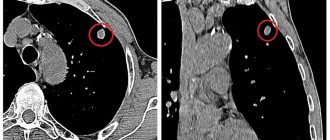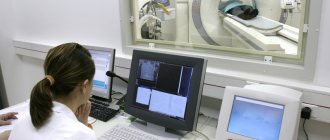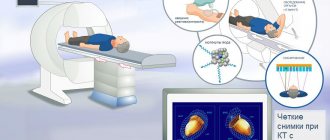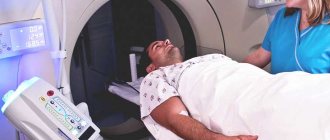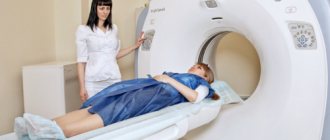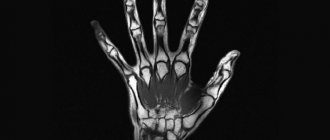MRI, like other diagnostic methods, is today the most effective and in demand in medicine, even for diagnosing a child’s body. But such a procedure, although it most accurately determines the disease, for some patients is prohibitive in terms of cost and anxiety for parents, who ask doctors a common question - is it possible to do an MRI for children?
What does brain MRI involve, and when do children need it?
MRI or magnetic resonance imaging is a diagnostic method that provides the ability to obtain images of internal organs and tissues using a magnetic field and radio frequency pulses. Detailed images are obtained as a result of the activation of hydrogen atoms in cells. However, the impact of the equipment is minimized and does not stimulate the body to respond to the immune or nervous systems.
General anesthesia is relevant if the child has epilepsy or other serious neurological diseases.
It is advisable to resort to MRI of the brain in children with the following clinical picture:
- the child faints without any obvious influence factors;
- there is a sharp decrease in hearing or vision;
- a convulsive state is periodically noted;
- the child often complains of headache or dizziness for no apparent reason;
- there is a significant developmental delay;
- there is a drastic change in behavior.
At what age can a CT scan be performed?
Experts say that CT can be done even on a newborn if there are absolute indications for the study and other examination methods are not informative. In the first year of life, a child’s brain can be examined using ultrasound – neurosonography. Due to the open fontanelle, ultrasonic waves make it possible to examine all the necessary brain structures. After closure of the fontanel, CT is used for examination. It is important to understand that in most cases, computed tomography is done for children to identify injuries and tumors, so the benefits of early diagnosis are much higher than the harm from radiation. There is no significant difference in CT scanning in newborns, one-year-old children, or children three to five years old.
How is an MRI of the head performed in children?
To obtain accurate tomography results, the child must remain motionless in the apparatus flask for a certain time. On average, the duration of diagnostics is 15-20 minutes. Even some teenagers, let alone children of the younger generation, cannot withstand this condition. That is why, when examining small patients, specialists decided to use general anesthesia. Anesthesia is especially relevant if a child has epilepsy or other serious neurological diseases.
Conditions for successful diagnosis
In order to obtain accurate examination results, experts recommend putting the child to bed a couple of hours later than usual in the evening the day before the MRI. At the same time, he should wake up an hour earlier. The anesthetic drug is administered according to the rules on an empty stomach. Therefore, the last meal you eat should be:
- for infants - no later than 2 hours before the procedure;
- in children older than one year - 4 hours before the start of diagnosis;
- for children over 6 years old - 8 hours before tomography.
Subtleties of the procedure
Before proceeding with magnetic resonance imaging, an anesthesiologist talks with the child’s parents. The specialist studies information about the patient’s concomitant diseases, the presence of allergic reactions to drugs, and behavioral characteristics. Relying on the collected anamnesis, the anesthesiologist selects an acceptable type of anesthesia. In total, in this case, 2 methods of falling asleep are used:
- Inhalation or mask - the drug is administered through an oxygen mask.
- Parenteral or injection - anesthesia enters the body through intravenous administration.
The drug is administered to the child, who is previously positioned on the tomograph couch. Special sensors are attached around the head area, which serve as recorders of signals coming from the brain during the examination. In addition, the patient is connected to a cardiac monitor and heart rate monitor, which allows the anesthesiologist to monitor the child’s condition remotely.
Possible complications during anesthesia and their prevention?
Over the past decade, there have been reports of the possibility of impaired brain function after general anesthesia in patients under 4 years of age, manifested by cognitive impairment, memory and attention impairment. However, this applies to a greater extent to long-term episodes of general anesthesia for major surgical interventions. It is possible that the likelihood of complications increases due to surgical trauma.
To perform anesthesia during MRI, special equipment is required, the parts of which are made of non-magnetic materials. Conventional inhalation anesthesia machines, cardiac monitors and heart rate monitors do not work in a magnetic field.
Anesthesia machine for working under magnetic resonance imaging conditions
Negative consequences after MRI under general anesthesia may be associated with complications during its implementation. Unfortunately, some anesthesiologists, under pressure from management, agree to provide anesthesia or sedation during MRI without having the full range of necessary equipment. At the same time, the risk of complications that may further affect the functioning of the patient’s brain and internal organs increases several times. In this case, it is better to refuse MRI and undergo examinations in a well-equipped diagnostic center.
Contraindications for MRI of the brain under anesthesia
It takes a specialist up to 30 minutes to decipher the diagnostic results.
Putting a child into deep sleep during magnetic resonance imaging is prohibited in the following cases:
- with rickets - metabolic disorders;
- presence of body weight deficiency;
- significant delay in mental or physical development. For example, the patient has no swallowing reflex;
- the patient has hyperthermia (accumulation of excess heat in the body) of unknown origin;
- exacerbation of pathologies of a neurological and psychiatric nature;
- in the presence of attacks of bronchial asthma;
- acute infectious and viral diseases;
- significant disturbances in the functioning of the cardiovascular system;
- severe severity of upper respiratory tract diseases.
Consequences of anesthesia
If the MRI was performed under general anesthesia, you should not leave the clinic immediately. He must remain under observation for several hours, sometimes the patient is left until the morning. During this time, the baby finally comes to his senses. Be sure to wait until he can eat and observe the reaction.
After anesthesia, the patient may remain drowsy. This reaction should not last more than a day. Mood swings during this period are considered normal. Anesthesia is not always safe. Some consequences are also possible after performing an MRI on a small child under anesthesia:
- anaphylactic shock;
- respiratory arrest;
- laryngo- or bronchiolospasm;
- arrhythmia or cardiac arrest;
- cramp or muscle pain, vomiting.
Such complications are possible if the dosage of the anesthesia drug is incorrect. The cause may also be problems with the cardiovascular system, neuralgia, or an individual reaction to the medicine.
The risk of these complications means that the anesthesiologist must be present during the entire procedure, as well as monitor the small patient for some time after it. The greatest danger is posed by anesthesia when administered to children under 2 years of age. This should be avoided if possible.
For children, magnetic resonance imaging is attractive due to its lack of invasive intervention, safety and painlessness. The procedure under anesthesia carries certain risks, but in some cases they are justified.
How safe is the brain MRI procedure?
Magnetic resonance imaging is used practically all over the world and is a unique device for identifying brain pathologies from the very first day of a baby’s life. Experts claim that, despite the significant frequency of the generated magnetic field, the technique in no way affects the health of the human body.
Over the entire period of using MRI in medicine, this method of hardware diagnostics has been tested on millions of children, and none of them had a recorded side effect when the equipment impacted the body. The only minor drawback of the diagnosis is the requirement for complete immobility in a confined space, which in the case of children requires the use of harmful anesthesia.
What are the characteristics of anesthesia for MRI?
The strong magnetic field that the tomograph emits during examination inhibits the operation of standard anesthesia devices. The use of special expensive equipment for MRI, which is resistant to the magnetic field, allows for the necessary diagnostics. These are the main features of anesthesia.
During the MRI imaging procedure, monitors are connected to the patient to help monitor the patient's condition. Due to strong radiofrequency emissions, an anesthesiologist cannot be present with each person during the study. Therefore, during the procedure, he is forced to be in the next room and monitor the patient’s condition through the window. For the person being examined, small doses of radiation during MRI are harmless.
Thanks to modern progress and the peculiarities of anesthesia, certified devices located in a medical institution make it possible to perform a high-quality procedure and ensure the safety of the patient. On the website “prokishechnik” you can find detailed materials on various diseases of the gastrointestinal tract.
Is it possible to do without anesthesia during the examination?
Contraindications to the use of anesthesia or reluctance to expose a child to medication is not a reason to refuse brain diagnostics. It is possible to use open circuit equipment. During the examination with such a device, it is enough for the child to lie on the couch, while the mother can be nearby, ensuring the immobility of her child.
Another option for solving the problem of the inability to use anesthesia is the use of MRI with special technology, which makes it possible to eliminate interference with the child’s movements, which affects the quality of the results. Of course, thanks to such a device, it will not be possible to obtain accurate examination results if the child actively shakes his head.
What types of anesthesia are used for MRI?
Depending on the specific case, the following types of anesthesia are recommended and used:
- sedation is the use of modern medications, with the help of which complete calm of the patient is achieved (medicines, for example, Relium, alprazolam);
- inhalation or intravenous, sometimes with artificial ventilation.
To determine the choice of a specific type of anesthesia, you should pay attention to the individual characteristics of the patient being examined. A qualified anesthesiologist will help you make the right choice, and the study will go well.
MRI results of the brain in children
On average, it takes a specialist up to 30 minutes to decipher the diagnostic results. Then the conclusion is handed over to the parents or transferred to the attending physician. The diagnostician often reports immediately about the presence of a serious pathology requiring immediate treatment.
Based on the above information, it follows that the consequences of MRI of the brain of children under anesthesia are negligible compared to the possibilities for diagnosing serious diseases that it provides.

